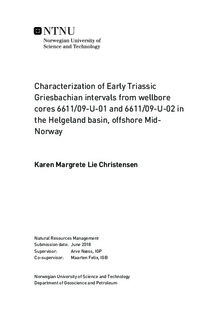Characterization of Early Triassic Griesbachian intervals from wellbore cores 6611/09-U-01 and 6611/09-U-02 in the Helgeland basin, offshore Mid-Norway
Master thesis
Permanent lenke
http://hdl.handle.net/11250/2572904Utgivelsesdato
2018Metadata
Vis full innførselSamlinger
Sammendrag
Cores 6611/09-U-01 and 6611/09-U-02 from the Helgeland basin cover a 750-metre-thick succession of marine sandstone, turbidites and shales. The upper 400 metres of the drilled cores are dated as the lower Triassic and referred to as the Griesbachian interval. The Griesbachian interval is the focus of interest in this thesis.
Sedimentological analyses from the Griesbachian interval in core 6611/09-U-01 and 6611/09U-02 were used to identify the variability of lithofacies, depositional elements and the depositional environment at the time of deposition. A sedimentological description was made, and 24 thin sections were analyzed. 6 lithofacies and 4 facies associations were made based on the observations from the sedimentological log and the thin sections. From the lithofacies interpreted, 4 facies associations were described all with different depositional processes: debris flow, turbidity current, transitional flow and hemipelagic settling.
Evaporitic intervals were observed in both core 6611/09-U-01 and 6611/09-U-02. Three models are proposed for interpreting the depositional process of the gypsum interval: sabkha environment, transportation and recrystallization. Based on thin sections and core observations the most favoured model with recrystallization of evaporitic sediment is proposed.
Statistical analysis based on observed thicknesses of facies association beds in core 6611/09U-01 and 6611/09-U-02 were performed to look at the thickness distributions through the core. Correlation of core 6611/09-U-01 and 6611/09-U-02 with regards to the evaporitic gypsum and a conceptual depositional model were carried out based on the sedimentological description, the facies associations interpretation and the statistical analysis. The conceptual depositional model for the Helgeland basin was proposed by a small-scale submarine fan system stacked in an aggradation pattern with sediment input by several feeder channels from east to west.
The result of this study is an integrated data analysis and facies model which represents the paleoenvironment within the deposition of the Griesbachian interval in the Helgeland Basin.
